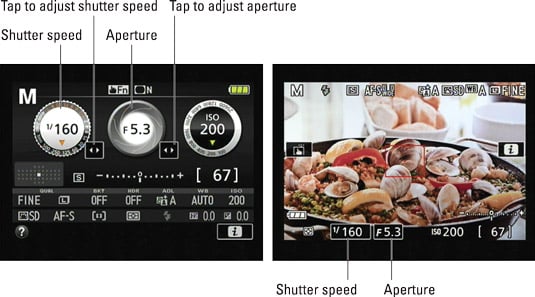

Reducing the shutter speed affects how motion is captured, in that this can cause the background or subject to become blurry.

Of course that by changing from f/5.6 to f/4 you reduced your depth of focus, and also shutter speed of 1/125s will make it harder to create blurring effect, but about these implications of different f-stops and shutter speeds I will write in another article.When these three elements are combined, they represent a given exposure value (EV) for a given setting.Īny change in any one of the three elements will have a measurable and specific impact on how the remaining two elements react to expose the film frame or image sensor and how the image ultimately looks.įor example, if you increase the f-stop, you decrease the size of the lens’ diaphragm thus reducing the amount of light hitting the image sensor, but also increasing the DOF (depth of field) in the final image.
#F stop and shutter speed manual#
Shutter speeds: 1/1000s 1/500s 1/250s 1/125s 1/60s 1/30s 1/15s 1/8s 1/4sĪnd the speed combinations that will result in same exposure to make it more clear – if you set your camera to automatic mode, take a shot and see that it used f5.6 f-stop with 1/60s shutter speed, you then can switch to manual mode and set f/4 with 1/125s and also have properly exposed photograph.
#F stop and shutter speed full#
What are original full f-stops and shutter speeds are then? Well, here they are for your (and mine) convenience:į-stops: f/1.4 f/2 f/2.8 f/4 f/5.6 f/8 f/11 f/16 f/22 So having modern digital camera denied me this knowledge of getting the same exposure due to having intermediate settings. Between the full f-stops there are now intermediate f-stops, and this fact confused me because now when I changed to the next f-stop I didn’t know whether it was a full one or an intermediate, same thing being with shutter speeds. In the modern cameras you can actually set more f-stops and shutter speed than these 9. This way you can continue changing the f-stop/shutter speed combinations but still have the same exposure. So if your correct exposure consists from a certain f-stop and a certain shutter speed from these nine, then to receive exactly the same exposure with different f-stop and shutter speed combination you’ll have, for example, to set one f-stop above your current one, and one shutter speed below your current one, thus you will close your aperture so that less light will hit the sensor, but at the same time you’ll prolong the time that the sensor is exposed, so eventually the same amount of light will hit the sensor. There are 9 full f-stops, and also 9 common shutter speeds (actually there are few more, but here I’ll concentrate on these). The answer is pretty simple, but with a little twist. So what exactly are the combinations of f-stop and shutter speed that result in the same exposure? Of course there are substantial differences between these two settings, which you also have to take under consideration, but both of them allow for the same exposure. There are many different combinations of f-stop and shutter speed that represent the same exposure, so for the same lighting conditions you can choose for example f/11 with 1/15s for correct exposure, but you can also choose f/2 with 1/500 for exactly the same exposure. But even that said I’ll start with a little theory, which may serve just as reminder for most of the readers (myself included) but for beginner photographers it might be even something they didn’t know before. I will say it right away that for this article to be of any use to you, you have to know what is f-stop, shutter speed, and exposure.

But there is a catch involved in it that I would like to focus your attention on in this article.

Many advanced amateur photographers are familiar with notion of f-stops and shutter speeds, and also know that there are many different combinations of f-stop+shutter speed that allow for the same amount of light to hit the sensor of the camera (or the film).


 0 kommentar(er)
0 kommentar(er)
